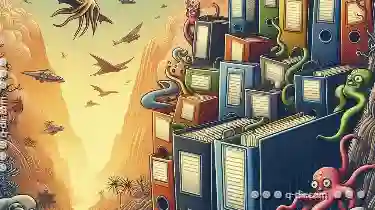Many users, however, find themselves inadvertently turning their desktops into productivity black holes. This blog post aims to explore why the desktop ...
 folder can be detrimental to your efficiency and offers practical tips for better file management practices. In today's fast-paced digital world, file management is more than just about storing documents; it's an essential aspect of productivity.
folder can be detrimental to your efficiency and offers practical tips for better file management practices. In today's fast-paced digital world, file management is more than just about storing documents; it's an essential aspect of productivity.1. Understanding the Desktop Folder
2. Why It's a Productivity Black Hole
3. Practical Tips for Better File Management
4. Conclusion
1.) Understanding the Desktop Folder
The desktop is often seen as a personal canvas where you can drag and drop files for easy access. However, this convenience can lead to clutter and disorganization over time. The pile-up of documents, icons, and shortcuts not only clutters your screen but also makes it harder to find specific files when needed.
2.) Why It's a Productivity Black Hole
1. Lack of Structure
Without proper categorization and organization, the desktop becomes chaotic. This can lead to significant time wasted in searching for files rather than working on tasks. The lack of structure contributes to mental clutter which is detrimental to focus and productivity.
2. Unintentional Procrastination
The ease with which you can add new files or shortcuts to your desktop can be addictive, making it tempting to use the desktop as a dumping ground for everything. This constant distraction leads to unintentional procrastination and reduces overall efficiency.
3. Inefficient Use of Storage
Desktops on laptops and especially on solid-state drives (SSDs) are typically not designed for extensive storage. Cluttering it with files can lead to rapid depletion of available space, which might necessitate constant cleaning or moving items elsewhere.
3.) Practical Tips for Better File Management
1. Use a Dedicated Organizational Tool
Consider using specialized file management software or apps that allow you to categorize and tag your documents in a more structured manner than the desktop allows. Tools like Evernote, Google Drive, or Dropbox can help keep all your files in one place with easy search functionality.
2. Create Logical Folders
Instead of letting everything pile up on the desktop, create logical folders for different types of content such as work, school, personal projects, and hobbies. This way, you can navigate to specific areas when needed without scrolling through numerous icons.
3. Regular Maintenance
Regularly clean up your file management system by organizing files into their respective folders and deleting any that are no longer necessary. This practice not only declutters your workspace but also helps in maintaining a clear overview of what you have.
4. Use File Naming Conventions
Use descriptive file names that include keywords relevant to the content, making it easier to find files based on their purpose or context using search tools like operating system searches or dedicated software.
5. Limit Desktop Icons
While it might seem convenient initially, having too many icons on your desktop can lead to visual clutter and mental clutter. Try to limit yourself to only essential shortcuts that are actively used.
4.) Conclusion
The desktop folder should serve as a quick access point for files you frequently use, not as a repository for all digital assets. By turning it into a productivity black hole due to lack of structure or constant procrastination, users can significantly improve their efficiency and focus by adopting better file management practices. Remember, the goal is to keep your workspace organized without letting disorganization lead to distraction and inefficiency.

The Autor: / 0 2025-02-15
Read also!
Page-

How to Manage Hidden Files in Preview Mode
When it comes to managing files and folders, the ability to view and control hidden files is often overlooked but can be incredibly useful. In this ...read more

Why Folders Will Either Evolve or Die in the Next Decade
From personal use to professional environments, efficient file management can save time, reduce confusion, and ensure that important information ...read more

Why Tabs Are the Most Requested Feature in File Explorer
Among various tools designed to streamline this process, tabs have emerged as a highly sought-after feature in file explorers. This blog post will ...read more